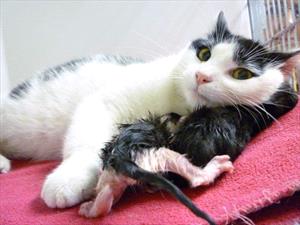
Puppies are born 58 to 72 days after mating. Because canine spermatozoa live 4 to 11 days in the bitch’s reproductive tract, it is usually not possible to accurately determine the day of birth from the time of mating. If purposefully breeding, ovulation timing can be performed to determine with much greater accuracy the expected delivery date. A cat’s gestation period is similar at 63 to 65 days.
If the contractions are frequent, regular, and strong, and no young is produced in 15 to 30 minutes, the pet should be taken to a veterinarian. Intermittent contractions with no kitten or puppy should be evaluated after 1.5 to 2 hours as long as the dam appears comfortable. A dark green vaginal discharge called lochia should be followed within 5 to 10 minutes by a puppy or kitten, but only before the first one. Heavy bleeding requires an immediate veterinary examination.
While a few cats can take up to 24 hours to complete the birthing process, most should follow the same protocol as for dogs.
About two out of three cases of difficult birth (known as dystocia) that need to be seen by a veterinarian will need to have an emergency C-section performed. It is good practice to know long before the due date where your local veterinary emergency facility is, and when and if they can perform a C-section. C-sections are risky and expensive surgeries and careful consideration should be given to the decision to breed your pet or not. X-rays taken after the 44th day of gestation (not necessarily from breeding) can show how many babies will be born but they are much easier to count when the skeletons are fully mineralized later in gestation, after day 50. This will allow you to know when the mother is done giving birth.
Reddish to brownish vaginal discharge can continue for several weeks after a normal birth. If the mother is eating normally and is normally active, this isn’t a problem. If she becomes lethargic, stops eating, has a fever or acts ill, prompt veterinary attention is needed.
Some new mothers can experience a condition called eclampsia in which their blood calcium levels drop dangerously low. This is due to the large amount of calcium secreted in milk for newborns. Dogs with eclampsia experience poor mothering, severe muscle tremors, difficulty walking, and seizures. Immediate veterinary care is needed if your dog is showing any of these signs. Eclampsia can happen anytime around birth but is most common during peak milk production (2 to 4 weeks after birth).
Cat birth

Photo by Dr. Teri Ann Oursler
What to Do
- Prepare a clean, warm, and easy-to-clean area for the birth. Puppy rails for whelping boxes are lifesavers for puppies.
- Check on the mother frequently without disturbing the process. Repeated interruptions will only delay birth.
- If a baby is visible in the birth canal and appears stuck, gently grasp the foot or feet with a clean cloth. With a steady motion gently pull upwards towards the dam’s tail on the baby only when the female is contracting. If the baby does not come out easily, transport the pet to a veterinarian.
- When the baby is born, it will likely be covered in a membrane. If the mother doesn't remove it, tear this membrane and remove it from the baby’s head region.
- If the mother doesn't remove the umbilical cord, or is being rough with it, tie it with a piece of string or dental floss one-fourth of an inch from the baby's abdomen. Then cut the cord one half of an inch from the abdomen with a sharp scissor on the dam’s side of the cord. Apply 2 percent tincture of iodine to the entire umbilicus (buy this beforehand, just in case).
- Keep the babies warm. It is best to leave them with their mother, but sometimes she doesn't stay with them. In that instance, put a plastic bottle filled with warm water near the babies. A hot water bottle covered with a towel works as does a Snuggle Safe™ disc. Neonates must have room and be strong enough to move away from the heat source. The room temperature should be around 85F. Allow room for the babies to move toward or away from the heat source.
What NOT to Do
- Do not put your fingers in the birth canal as you can cause trauma or infection.
- Do not forcibly attempt to remove a baby.
- Do not assist delivery by pulling on the head of a baby or on the umbilical cord as it exits the mother.
- Do not lift the baby by the umbilical cord.
- Do not use a heating pad.
- Most kitten and puppy births go smoothly with the mother doing all the work. The babies contentedly nurse on the mother soon after birth.
- You may not see the afterbirth (placenta) being passed. Many mothers will eat this after it is passed without anyone noticing. It’s usually not a problem if all of the placentas are not immediately passed as the dam usually passes them later, but on occasion retained placentas do not pass and in those cases can cause serious illness.
(Reproduction specialist Dr. Joni Freshman contributed to this article.)
Browse the complete Veterinary Partner First Aid collection.